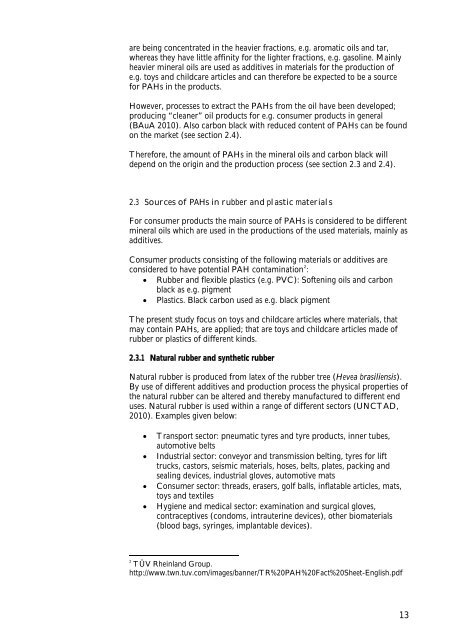PAHs in toys and childcare products - Miljøstyrelsen
PAHs in toys and childcare products - Miljøstyrelsen
PAHs in toys and childcare products - Miljøstyrelsen
Create successful ePaper yourself
Turn your PDF publications into a flip-book with our unique Google optimized e-Paper software.
are be<strong>in</strong>g concentrated <strong>in</strong> the heavier fractions, e.g. aromatic oils <strong>and</strong> tar,<br />
whereas they have little aff<strong>in</strong>ity for the lighter fractions, e.g. gasol<strong>in</strong>e. Ma<strong>in</strong>ly<br />
heavier m<strong>in</strong>eral oils are used as additives <strong>in</strong> materials for the production of<br />
e.g. <strong>toys</strong> <strong>and</strong> <strong>childcare</strong> articles <strong>and</strong> can therefore be expected to be a source<br />
for <strong>PAHs</strong> <strong>in</strong> the <strong>products</strong>.<br />
However, processes to extract the <strong>PAHs</strong> from the oil have been developed;<br />
produc<strong>in</strong>g “cleaner” oil <strong>products</strong> for e.g. consumer <strong>products</strong> <strong>in</strong> general<br />
(BAuA 2010). Also carbon black with reduced content of <strong>PAHs</strong> can be found<br />
on the market (see section 2.4).<br />
Therefore, the amount of <strong>PAHs</strong> <strong>in</strong> the m<strong>in</strong>eral oils <strong>and</strong> carbon black will<br />
depend on the orig<strong>in</strong> <strong>and</strong> the production process (see section 2.3 <strong>and</strong> 2.4).<br />
2.3 Sources of <strong>PAHs</strong> <strong>in</strong> rubber <strong>and</strong> plastic materials<br />
For consumer <strong>products</strong> the ma<strong>in</strong> source of <strong>PAHs</strong> is considered to be different<br />
m<strong>in</strong>eral oils which are used <strong>in</strong> the productions of the used materials, ma<strong>in</strong>ly as<br />
additives.<br />
Consumer <strong>products</strong> consist<strong>in</strong>g of the follow<strong>in</strong>g materials or additives are<br />
considered to have potential PAH contam<strong>in</strong>ation 2 :<br />
� Rubber <strong>and</strong> flexible plastics (e.g. PVC): Soften<strong>in</strong>g oils <strong>and</strong> carbon<br />
black as e.g. pigment<br />
� Plastics. Black carbon used as e.g. black pigment<br />
The present study focus on <strong>toys</strong> <strong>and</strong> <strong>childcare</strong> articles where materials, that<br />
may conta<strong>in</strong> <strong>PAHs</strong>, are applied; that are <strong>toys</strong> <strong>and</strong> <strong>childcare</strong> articles made of<br />
rubber or plastics of different k<strong>in</strong>ds.<br />
2.3.1 Natural rubber <strong>and</strong> synthetic rubber<br />
Natural rubber is produced from latex of the rubber tree (Hevea brasiliensis).<br />
By use of different additives <strong>and</strong> production process the physical properties of<br />
the natural rubber can be altered <strong>and</strong> thereby manufactured to different end<br />
uses. Natural rubber is used with<strong>in</strong> a range of different sectors (UNCTAD,<br />
2010). Examples given below:<br />
� Transport sector: pneumatic tyres <strong>and</strong> tyre <strong>products</strong>, <strong>in</strong>ner tubes,<br />
automotive belts<br />
� Industrial sector: conveyor <strong>and</strong> transmission belt<strong>in</strong>g, tyres for lift<br />
trucks, castors, seismic materials, hoses, belts, plates, pack<strong>in</strong>g <strong>and</strong><br />
seal<strong>in</strong>g devices, <strong>in</strong>dustrial gloves, automotive mats<br />
� Consumer sector: threads, erasers, golf balls, <strong>in</strong>flatable articles, mats,<br />
<strong>toys</strong> <strong>and</strong> textiles<br />
� Hygiene <strong>and</strong> medical sector: exam<strong>in</strong>ation <strong>and</strong> surgical gloves,<br />
contraceptives (condoms, <strong>in</strong>trauter<strong>in</strong>e devices), other biomaterials<br />
(blood bags, syr<strong>in</strong>ges, implantable devices).<br />
2<br />
TÜV Rhe<strong>in</strong>l<strong>and</strong> Group.<br />
http://www.twn.tuv.com/images/banner/TR%20PAH%20Fact%20Sheet-English.pdf<br />
13

















